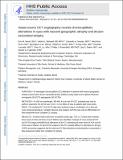SWEPT-SOURCE OPTICAL COHERENCE TOMOGRAPHY ANGIOGRAPHY REVEALS CHORIOCAPILLARIS ALTERATIONS IN EYES WITH NASCENT GEOGRAPHIC ATROPHY AND DRUSEN-ASSOCIATED GEOGRAPHIC ATROPHY
Author(s)
Moult, Eric Michael; Choi, WooJhon; Lee, ByungKun; Ploner, Stefan B; Lu, Chen David; Fujimoto, James G; ... Show more Show less
DownloadAccepted version (3.774Mb)
Open Access Policy
Open Access Policy
Creative Commons Attribution-Noncommercial-Share Alike
Alternative title
Swept source OCT angiography reveals choriocapillaris alterations in eyes with nascent geographic atrophy and drusen-associated atrophy
Terms of use
Metadata
Show full item recordAbstract
Purpose: To investigate choriocapillaris (CC) alteration in patients with nascent geographic atrophy (nGA) and/or drusen-associated geographic atrophy (DAGA) using swept-source optical coherence tomography angiography (OCTA). Methods: A 1,050-nm wavelength, 400 kHz A-scan rate swept-source optical coherence tomography prototype was used to perform volumetric swept-source optical coherence tomography angiography over 6 mm × 6 mm fields of view in patients with nGA and/or DAGA. The resulting optical coherence tomography (OCT) and OCTA data were analyzed using a combination of en face and cross-sectional techniques. Variable interscan time analysis (VISTA) was used to differentiate CC flow impairment from complete CC atrophy. Results: A total of 7 eyes from 6 patients (mean age: 73.8 ± 5.7 years) were scanned. Seven areas of nGA and three areas of DAGA were identified. Analysis of cross-sectional OCT and OCTA images identified focal alterations of the CC underlying all seven areas of nGA and all three areas of DAGA. En face OCTA analysis of the CC revealed diffuse CC alterations in all eyes. Variable interscan time analysis processing suggested that the observed CC flow alterations predominantly corresponded to flow impairment rather than complete CC atrophy. Conclusion: The OCTA imaging of the CC revealed focal CC flow impairment associated with areas of nGA and DAGA, as well as diffuse CC flow impairment throughout the imaged field. En face OCT analysis should prove useful for understanding the pathogenesis of nGA and DAGA and for identifying the formation of nGA and DAGA as endpoints in therapeutic trials.
Date issued
2016-12Department
Massachusetts Institute of Technology. Institute for Medical Engineering & Science; Massachusetts Institute of Technology. Department of Electrical Engineering and Computer Science; Massachusetts Institute of Technology. Research Laboratory of ElectronicsJournal
Retina
Publisher
Lippincott
Citation
Moult, Eric M. et al. “Swept source OCT angiography reveals choriocapillaris alterations in eyes with nascent geographic atrophy and drusen-associated atrophy.” Retina, 36 (Suppl 1), 12 (December 2020): S2–S11 © 2016 The Author(s)
Version: Author's final manuscript
ISSN
0275-004X